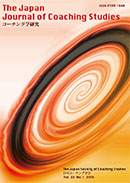Volume 33, Issue 1
Displaying 1-8 of 8 articles from this issue
- |<
- <
- 1
- >
- >|
Special articles
-
2019Volume 33Issue 1 Pages 1-12
Published: October 20, 2019
Released on J-STAGE: November 19, 2019
Download PDF (366K)
-
2019Volume 33Issue 1 Pages 13-20
Published: October 20, 2019
Released on J-STAGE: November 19, 2019
Download PDF (290K)
Original articles
-
2019Volume 33Issue 1 Pages 21-30
Published: October 20, 2019
Released on J-STAGE: November 19, 2019
Download PDF (611K) -
Analysis of technical tasks for discus throws in decathletes using a observational evaluation method2019Volume 33Issue 1 Pages 31-41
Published: October 20, 2019
Released on J-STAGE: November 19, 2019
Download PDF (384K) -
2019Volume 33Issue 1 Pages 43-54
Published: October 20, 2019
Released on J-STAGE: November 19, 2019
Download PDF (331K) -
2019Volume 33Issue 1 Pages 55-64
Published: October 20, 2019
Released on J-STAGE: November 19, 2019
Download PDF (618K) -
2019Volume 33Issue 1 Pages 65-77
Published: October 20, 2019
Released on J-STAGE: November 19, 2019
Download PDF (1059K)
Case report
-
2019Volume 33Issue 1 Pages 79-91
Published: October 20, 2019
Released on J-STAGE: November 19, 2019
Download PDF (421K)
- |<
- <
- 1
- >
- >|
